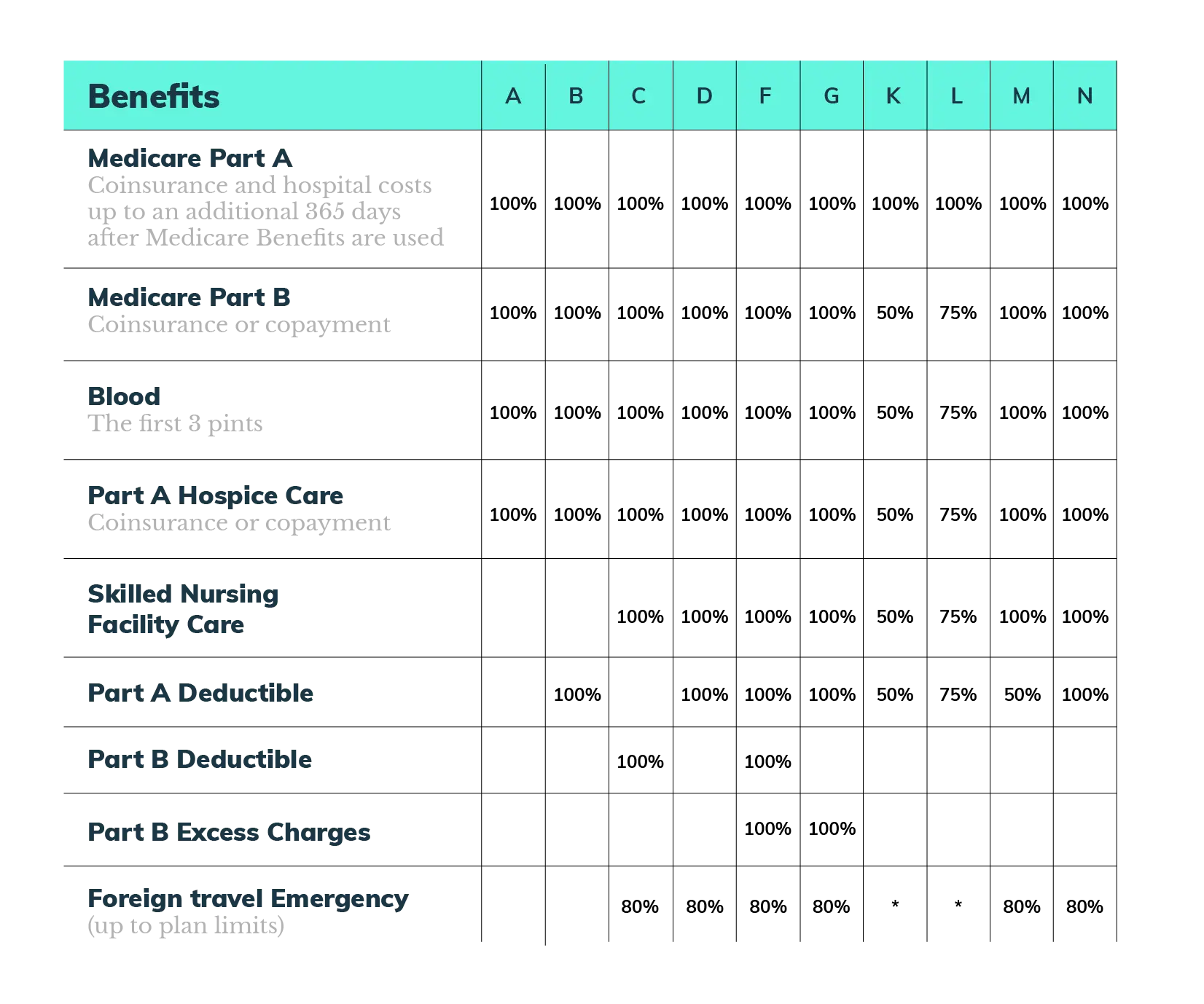The Ultimate Guide to Medicare Supplement Plans in North Carolina
Read on to learn more about how seniors in North Carolina manage their out-of-pocket Medicare expenses.
Our content follows strict guidelines for editorial accuracy and integrity. Learn about our and how we make money.
Enrolling in the federal Medicare program is a great way to lower health care costs and medical bills.
However, it won’t cover all your medical expenses and there are additional costs, like monthly premiums and coinsurance, that you will have to pay.
Some people turn to Medicare Supplement Insurance to help them with these costs and to get added cover to their Original Medicare.
This article will discuss Medicare Supplement Plans in North Carolina, which ones are most popular, when the best time is to apply and how much you can expect to pay.
Let’s Recap: What Are Medicare Supplement Plans?
A Medicare Supplement Insurance, also known as a Medigap policy, is a type of health plan that private insurance companies sell to Medicare beneficiaries.
These plans cover medical expenses such as coinsurance, deductibles, and copayments, and provide additional insurance for medical expenses.
Medicare Supplement Insurance is only available to people who have Original Medicare. If you have a Medicare Advantage or Prescription Drug Plan (Part D), you won’t be able to buy a Medicare Supplement Plan.
In North Carolina, private insurance companies sell 12 standardized Supplement Plans.
Each plan can be identified by a letter: A, B, C, D, F, G, K, L, M and N.
There are also two “high-deductible” versions of Plan F and G. These are plans that have low monthly premiums but which charge a high deductible amount before they cover medical costs (in 2021, this was $2,370).
Medicare Supplement Plans offer the same benefits in all states except Wisconsin, Minnesota, and Massachusetts.
This means a Medicare Supplement plan in California will have the same benefits as one in Florida, Wyoming, or Alaska.
Terms You Need to Know:
Deductible: These are amounts Medicare beneficiaries have to pay for services, tests, and items before their insurance starts to cover them.
Coinsurance: These are the portion of costs that Medicare beneficiaries must pay.
Copayment: These are fixed amounts that Medicare plans set for specific services, procedures, and treatments.
Out-of-pocket expenses: These are costs that Original Medicare or a private Medicare plan doesn’t cover. For example, coinsurance, deductibles, and copayments are all types of out-of-pocket expenses.
The amount of coverage you receive will depend on which Medicare Supplement Plan you choose.
Each plan is different but will generally cover one or more of these costs:
Your deductibles: The amount you need to pay before your Medicare plan begins to cover your medical expenses.
Coinsurance: The portion of health care costs you must pay (for Medicare Part B, this is 20% of the costs, and for Part A this is a daily rate).
Other out-of-pocket costs: This can include excess charges and foreign emergency cover, which Original Medicare doesn’t pay for.
If you would like to learn more about Medicare Supplement Plans and what they offer, be sure to read this article.
Key Takeaways:
Medicare Supplement Plans are also known as Medigap Plans.
Medicare Supplement Insurance Plans help to pay for medical expenses that
Original Medicare won’t cover.
Medicare Supplement Plans are standardized across the U.S., except in Wisconsin, Minnesota, and Massachusetts.
There are ten different Medicare Supplement Plans you can choose from in North Carolina. They can be identified by a letter: A, B, C, D, F, G, K, L, M and N.
If you already have Medicaid or a Medicare Advantage Plan, an insurance company cannot sell you a Supplement Plan.
When Is the Best Time to Enroll in a Medicare Supplement Plan in North Carolina?
You can enroll in Medicare Supplement Insurance Plans at any time of the year in North Carolina. However, the recommended time to do it is in your Open Enrollment Period (OEP).
During your OEP, you’ll get better Medicare premiums, have more options available to you, and you will not need to go through medical underwriting.
What Is Medical Underwriting?
Medical underwriting is an examination of your medical history which health insurance companies use to determine:
Whether or not they will accept a person into a plan.
How much a person‘s monthly premiums will be.
Waiting periods for chronic conditions and health expenses.
During your OEP, health insurance companies aren't allowed to perform medical underwriting.
The CMS (Centers for Medicare and Medicaid Services) enforces this to ensure that every eligible Medicare beneficiary has a fair chance to get supplemental coverage.
When Does the Open Enrollment Period (OEP) Begin?
Your OEP will generally only happen once in your life when you enroll in Medicare and your Part B coverage starts.
However, if you become eligible for Medicare before 65 and collect Social Security Disability Income, you may get a second opportunity. For example, people who suffer from End-Stage Renal Disease are eligible for Medicare at any age.
The Open Enrollment Period starts in the month when your Medicare Part B coverage becomes effective and lasts for six months.
For example, if your Medicare Part B coverage starts on October 16th, your OEP will begin on October 1st and end on April 1st (6 months later).
Don’t get the Open Enrollment Period mixed up with the Initial Enrollment Period. Here’s how they’re different:
Open Enrollment Period vs Initial Enrollment Period
| Initial Enrollment Period | Open Enrollment Period | |
|---|---|---|
| What is it for? | Joining Original Medicare (Part A and B). | Joining a Medicare Supplement Plan. |
| When does it start? | 3 months before your 65th birthday month. | The first day of the month that your Part B cover begins. |
| How long does it last? | 7 months. | 6 months. |

(Source: Pexels)
The OEP is one of many Medicare Enrollment Periods that seniors have to try and make sense of. We’ve put together this table to outline the differences between each one:
| Enrollment Period | Description |
|---|---|
| Open Enrollment Period | This six-month period begins on the first day of the month when you are 65 or older, and your Medicare Part B insurance starts. This date will be different for everyone and depends on the month that you sign up. |
| Fall Medicare Open Enrollment Period | During this window, you can change your Medicare Supplement Insurance Plan without losing any medical coverage. This window takes place every year from October 15th to December 7th. |
| Initial Enrollment Period (IEP) | This is your first chance to sign up for Medicare once you are eligible and begins three months before your 65th birthday. You can sign up for Medicare Parts A and B, a Medicare Advantage Plan or a Part D Prescription Drug Plan. |
| General Enrollment Period | From January 1st to March 31st you can sign up for Medicare Parts A and B, as well as a Medicare Advantage Plan if you missed the deadline. |
| Special Enrollment Period | This period refers to specific situations where you can enroll outside the regular enrollment periods (for example, if you move states or your healthcare coverage under an employer ends). The dates for the Special Enrollment Period differ from person to person. |
You can read about these different enrollment periods in our guide to Medicare Open Enrollment Period 2022.
What Are the Most Popular Medicare Supplement Plans?
As we mentioned before, there are ten different Medicare Supplement Insurance Plans that you can choose from. They can be identified by a letter: A, B, C, D, F, G, K, L, M and N.
The table below summarizes the basic benefits that each plan covers.
Where you see a percentage, the Medicare Supplement Plan covers that percentage of the benefit and you must pay the rest.

Some of these Medicare plans have important details you should be aware of. For example:
Plans F and G have high-deductible versions in some states. This means that if you choose one of these plans, you must pay a deductible fee of $2,370 before your insurance pays anything.
Plans K and L have out-of-pocket limits of $6,220 and $3,110. Once you have paid these amounts and the Part B deductible of $233, the plan will pay 100% of your covered services for the rest of the year.
Plans C and F aren’t available to people who are newly eligible for Medicare on or after 1 January 2020.
Plan N will pay 100% of the Part B coinsurance. However, you will have to pay up to $20 for doctor visits and $50 for emergency room visits (as long as you are not admitted to the hospital).
Let’s Take a Look at the Most Popular Plans in North Carolina
Of the Medicare Supplement Plans available in North Carolina, research shows that Plan F, G, and N were the most popular in 2019.
Medicare Supplement Plan Enrollment Numbers (2019)
Plan F: 274,058
Plan G: 160,051
Plan N: 33,613
Plan F is popular since it covers most Part A and B costs like deductibles and coinsurance.
Plan F is available in both a standard and a high-deductible option. If you choose the high-deductible plan, you will be required to pay a $2,370 deductible fee before your plan begins to cover you.
Remember:
Medicare Part B covers outpatient services like specialist consultations, vaccines, screenings and walkers.
A deductible is a set amount you cover for health care before your insurance begins to pay.
Unfortunately, Plan F is only available to people who became eligible for Medicare before January 1, 2020. This is because Medicare has phased out Supplemental insurance plans that pay the Medicare Part B deductible.
If you were eligible for Medicare before 2020, you might still be able to buy Plan F in Georgia.
If you’d like to find out more about the eligibility requirements of Medicare Supplement Plan F and how much it could cost you, read this article.

(Source: Pexels)
Medicare Supplement Plan G
Plan G is another popular choice to lower Medicare’s out-of-pocket costs.
It covers Part A and B deductibles, 100% of coinsurance costs, Part B excess charges, and also covers foreign travel emergencies.
Plan G also has a high-deductible option of $2,370, but this is only available to people who turned 65 before January 1, 2020.
The standard Plan G does not cover the Medicare Part B deductible and is available to all Medicare beneficiaries.
Check out our article about Plan G for more information on what it covers and how much you can expect to pay.
Medicare Supplement Plan N
Many people choose Plan N because it covers Part A and B coinsurance, hospice care, Part A deductibles, and care in a skilled nursing facility.
However, it doesn’t cover Part B deductibles ($233 per benefit period) and Part B excess charges.
Excess charges are amounts that are higher than Medicare’s approved rates. This means you would have to cover those out-of-pocket expenses yourself.
For example, if an operation costs $750 more than the Medicare-approved amount:
Medicare and your Plan N insurance will not cover the extra cost.
You will be responsible for 20% of the costs (coinsurance), but Medicare will cover the other 80%.
But you'll also have to pay the extra amount of $750.
If you’d like to learn more, check out our article on Medicare Plan N to find out about coverage, costs, and benefits.
How Much Do Medicare Supplement Plans Cost in North Carolina?
While Medicare Supplement Plan benefits are standardized, monthly rates can vary between health insurance providers.
Health insurance companies may charge more or less because:
They want to primarily offer Medicare Supplement Insurance to people who don’t use tobacco.
They only offer Medicare Supplement Plans in certain areas.
They want to ensure that their members have proper coverage.
In general, an insurance company can set their premiums in three ways. These are:
Community-rated: Premiums aren’t based on age. This means that the same monthly premium is charged to everyone. However, the price will vary according to inflation.
Issue-age rated: Premiums are based on your age when you buy the policy and won’t change as you get older. This means premiums are lower for people who buy it at a younger age.
Attained-age rated: Premiums are calculated based on your current age and will increase as you get older. Although these plans may be affordable initially, they become expensive over time.
Location and lifestyle choices of members are taken into account when a health insurance company determines premiums.
Let’s look at an example to give you an idea of how much Medicare Supplement Plans could cost you in North Carolina.
Meet Elaine
Elaine is a 68-year-old woman living in Raleigh, North Carolina. Her postcode is 27513, and she doesn’t use tobacco.
She recently enrolled in Medicare after her union health coverage ended and is deciding between Medicare Supplement Plans B, C, and D. Let’s take a look at her options:
Pricing Disclaimer:
Note that all prices and costs mentioned are estimates and should not be viewed as the amount you will pay for Medicare Supplement Insurance.
All displayed prices and charges are subject to change. If you want to know how much supplemental insurance might cost you, contact PolicyScout to get an accurate estimate.

(Source: Pexels)
Plan BIn North Carolina, Plan B monthly premiums for Elaine will range between $104 to $304. This does not include the $170.10 standard monthly premium for the Part B deductible.
If she chooses this plan, she will not have any copayments or coinsurance. However, she will have to meet the $233 Medicare Part B deductible.
Example - Elaine’s Monthly Expenses for Plan B
Plan B Monthly Premium: $104 to $304
Part B Monthly Premium: $170.10
Total Monthly Costs: $274.10 - $474.10
This plan does not cover the Part B excess charges. This means that Elaine could pay up to 15% more if she visits a doctor who does not accept Medicare.
If Elaine ever needed care in a skilled nursing facility, Plan B would not cover these expenses.
Plan B Benefits:
❌ Skilled Nursing Facility
✅ Part A Deductible
❌ Part B Deductible
❌ Part B Excess Charges
❌ Foreign Travel Emergency
Elaine can buy Plan C because she turned 65 before 2020. If she turned 65 after January 1st 2020, she would not be eligible to purchase Plan C coverage.
In Raleigh, Plan C premiums will cost between $114 and $334 per month. But this does not include the $170.10 standard monthly premium for Medicare Part B.
Example - Elaine’s Monthly Expenses for Plan C
Plan C Monthly Premium: $114 - $334.00
Part B Monthly Premium: $170.10
Total Monthly Costs: $284.10 - $504.10
Plan C covers Part A and B coinsurance and deductibles. However, if Elaine uses a medical provider that charges more than Medicare-approved amounts (Part B excess charges) she will need to pay the difference.
If she is hospitalized or requires care in a skilled nursing facility, she won’t have to pay any extra costs.
She will also be covered for medical emergencies if she decides to travel out of the U.S. Once she pays a $250 deductible, her Plan C cover will pay 80% of foreign travel medical costs (up to a maximum of $50,000 in her lifetime).
Plan C Benefits:
✅ Skilled Nursing Facility
✅ Part A Deductible
✅ Part B Deductible
❌ Part B Excess Charges
✅ Foreign Travel Emergency Cover (80%)
A Recap of Key Terms:
Deductible: Amounts that you must initially pay before your insurance begins to cover medical expenses.
Coinsurance: Are portions of costs or rates that you pay for medical expenses.
Copayment: Are rates or fees that you must pay for doctor visits, hospital stays, and prescription drugs.
In North Carolina, Medicare Plan D monthly premiums range between $104 to $300. However, this doesn’t include the $170.10 standard Part B premium.
Example - Elaine’s Monthly Expenses for Plan D
Plan C Monthly Premium: $104 - $300
Part B Monthly Premium: $170.10
Total Monthly Costs: $274.10 - $470.10
Elaine will not have any copayments or coinsurance with Plan D, but she will have to pay a $233 Medicare Part B deductible before her insurance starts.
Her Medicare Supplement Insurance also won’t cover Part B (outpatient) costs that are higher than Medicare-approved rates for services, tests, and items (these are known as Part B excess charges).
With Plan D, Elaine will get foreign emergency travel benefits to a maximum lifetime benefit of $50,000. However, she will have to pay a $250 deductible before these benefits start.
Plan D Benefits:
✅ Skilled Nursing Facility
✅ Part A Deductible
❌ Part B Deductible
❌ Part B Excess Charges
✅ Foreign Travel Emergency
This table summarizes the costs and benefits of each Medicare Supplement Plan that Elaine is interested in:
| Plan B | Plan C | Plan D | |
|---|---|---|---|
| Monthly premiums | $104 to $304 | $114 - $334 | $104 - $300 |
| Medicare Part B premium cover | No | No | No |
| Copayments | None for approved Part B (outpatient) services. | None for approved Part B (outpatient) services. | None for approved Part B (outpatient) services. |
| Deductible costs | $233 (Part B) | None | $233 (Part B) |
| Foreign Travel Emergency Cover | No | Yes | Yes |
| Part B Excess Charges | Not covered | Not covered | Not covered |
As you can see, the premiums, benefits, and coverage options for different Medicare Supplement Insurance plans are wide-ranging.
If you’d like to get an idea of how much you could expect to pay for Medicare Supplement Insurance, visit the official website of the federal Medicare program.
It’s always a good idea to compare prices, coverage, and benefits before enrolling in a plan. By doing this, you can save money and find a plan that will cover your medical costs.

(Source: Pexels)
Where Can I Find Out More about Medicare and Supplement Insurance?
We understand that Medicare can be confusing but with the right advice and guidance, anyone can get the coverage they need. At PolicyScout, our job is to help people across the U.S. with their Medicare needs.
If you’re interested in learning about Medicare, Medicare Advantage plans, enrollments, costs, and coverage, our Medicare Hub has the information you’re looking for.
If you’d like to discuss your options with a licensed insurance agent or one of our Medicare experts, reach out at 1-888-912-2132 or send an email to Help@PolicyScout.com.